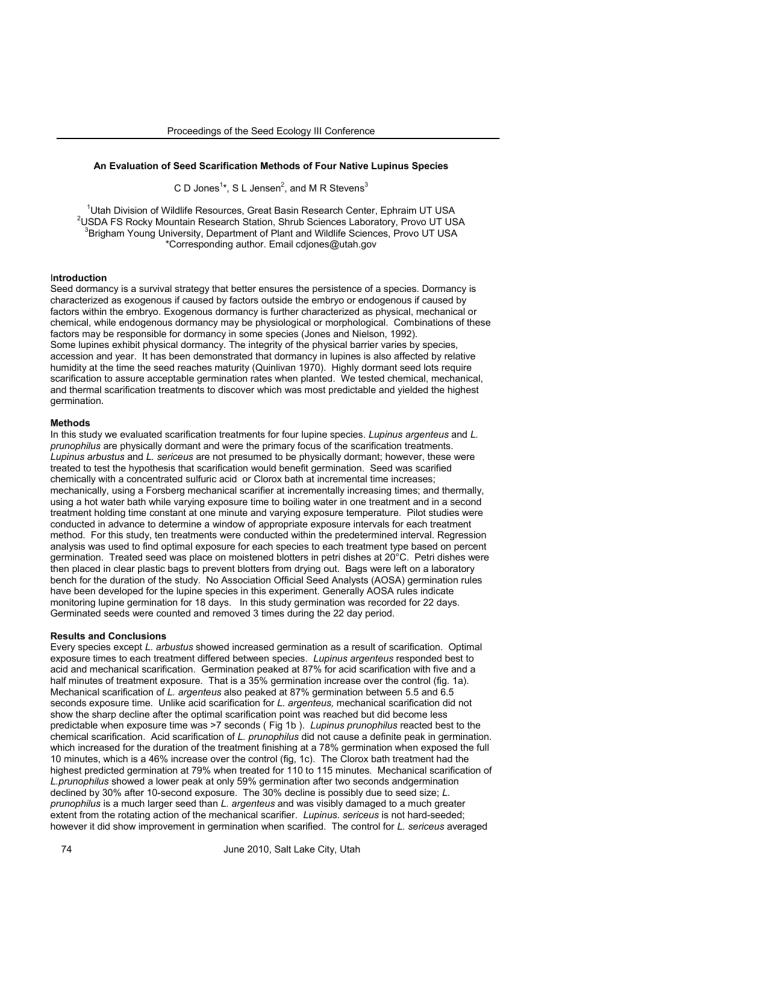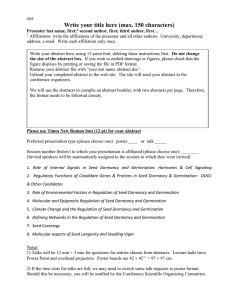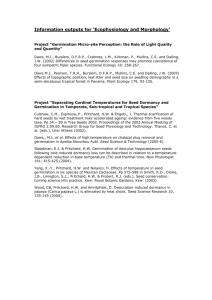Proceedings of the Seed Ecology III Conference C D Jones

Proceedings of the Seed Ecology III Conference
An Evaluation of Seed Scarification Methods of Four Native Lupinus Species
C D Jones 1 *, S L Jensen 2 , and M R Stevens 3
2
1 Utah Division of Wildlife Resources, Great Basin Research Center, Ephraim UT USA
USDA FS Rocky Mountain Research Station, Shrub Sciences Laboratory, Provo UT USA
3 Brigham Young University, Department of Plant and Wildlife Sciences, Provo UT USA
*Corresponding author. Email cdjones@utah.gov
I ntroduction
Seed dormancy is a survival strategy that better ensures the persistence of a species. Dormancy is characterized as exogenous if caused by factors outside the embryo or endogenous if caused by factors within the embryo. Exogenous dormancy is further characterized as physical, mechanical or chemical, while endogenous dormancy may be physiological or morphological. Combinations of these factors may be responsible for dormancy in some species (Jones and Nielson, 1992).
Some lupines exhibit physical dormancy. The integrity of the physical barrier varies by species, accession and year. It has been demonstrated that dormancy in lupines is also affected by relative humidity at the time the seed reaches maturity (Quinlivan 1970). Highly dormant seed lots require scarification to assure acceptable germination rates when planted. We tested chemical, mechanical, and thermal scarification treatments to discover which was most predictable and yielded the highest germination.
Methods
In this study we evaluated scarification treatments for four lupine species.
Lupinus argenteus and L. prunophilus are physically dormant and were the primary focus of the scarification treatments.
Lupinus arbustus and L. sericeus are not presumed to be physically dormant; however, these were treated to test the hypothesis that scarification would benefit germination. Seed was scarified chemically with a concentrated sulfuric acid or Clorox bath at incremental time increases; mechanically, using a Forsberg mechanical scarifier at incrementally increasing times; and thermally, using a hot water bath while varying exposure time to boiling water in one treatment and in a second treatment holding time constant at one minute and varying exposure temperature. Pilot studies were conducted in advance to determine a window of appropriate exposure intervals for each treatment method. For this study, ten treatments were conducted within the predetermined interval. Regression analysis was used to find optimal exposure for each species to each treatment type based on percent germination. Treated seed was place on moistened blotters in petri dishes at 20°C. Petri dishes were then placed in clear plastic bags to prevent blotters from drying out. Bags were left on a laboratory bench for the duration of the study. No Association Official Seed Analysts (AOSA) germination rules have been developed for the lupine species in this experiment. Generally AOSA rules indicate monitoring lupine germination for 18 days. In this study germination was recorded for 22 days.
Germinated seeds were counted and removed 3 times during the 22 day period.
Results and Conclusions
Every species except L. arbustus showed increased germination as a result of scarification. Optimal exposure times to each treatment differed between species. Lupinus argenteus responded best to acid and mechanical scarification. Germination peaked at 87% for acid scarification with five and a half minutes of treatment exposure. That is a 35% germination increase over the control (fig. 1a).
Mechanical scarification of L. argenteus also peaked at 87% germination between 5.5 and 6.5 seconds exposure time. Unlike acid scarification for L. argenteus, mechanical scarification did not show the sharp decline after the optimal scarification point was reached but did become less predictable when exposure time was >7 seconds ( Fig 1b ). Lupinus prunophilus reacted best to the chemical scarification. Acid scarification of L. prunophilus did not cause a definite peak in germination. which increased for the duration of the treatment finishing at a 78% germination when exposed the full
10 minutes, which is a 46% increase over the control (fig, 1c). The Clorox bath treatment had the highest predicted germination at 79% when treated for 110 to 115 minutes. Mechanical scarification of
L.prunophilus
showed a lower peak at only 59% germination after two seconds andgermination declined by 30% after 10-second exposure. The 30% decline is possibly due to seed size; L. prunophilus is a much larger seed than L. argenteus and was visibly damaged to a much greater extent from the rotating action of the mechanical scarifier. Lupinus. sericeus is not hard-seeded; however it did show improvement in germination when scarified. The control for L. sericeus averaged
74 June 2010, Salt Lake City, Utah
Proceedings of the Seed Ecology III Conference only 22% germination, while two seconds of exposure time in the mechanical scarifier increased germination by over 3.5 times, to 80%. This accession has demonstrated highemergence when used in greenhouse and field plantings without scarification; the low control germination percentage may mean that 22 days is not an adequate duration for germination without scarification. We demonstrated that some scarification on L. sericeus may help with increased uniformity of germination allowing 80% of the seed to germinate before 22 days. This could also lead to better establishment in a field setting by allowing scarified seed to put down a root more quickly than unscarified seed before soil moisture is lost. All scarification treatments on L. arbustus damaged the embryo, negatively impacting germination. The seed coat on L. arbustus is noticeably thinner than the other species in this study and this could explain the embryo damage. This study clarified which scarification methods yield best germination in these four lupine species and for these particular accessions. Continued research will focus on using this data as a baseline to test multiple accessions of these same species from Great
Basin biotypes. This will allow us to better predict how each scarification method would act on a given species and thereby improve germination for cultivation of that species for use in restoration.
References
Jones, T.A., & Nielson, D.C. (1992). Germination of prechilled mechanically scarified and unscarified Indian Ricegrass Seed. J. of Range Management 45: 175-179.
Quinlivan, B.J. (1970). The interpretation of germination tests on seeds of lupinus species which develop impermeability. Proc.
Int. Seed Test Ass. 35: 349-359.
A. B. C.
R
2
= 0.73 p = 0.02
R
2
= 0.86 p = 0.002
R 2 = 0.73 p = 0.02
Figure 1. Fraction of germination vs. exposure time, non-linear regression equations used to predict germination response to a specific exposure treatment and time. A. Regression equation = Peak, Log
Normal, 4 Parameter B. Regression equation = Log Normal, 4 Parameter C. Regression equation:
Sigmoidal, Weibull, 4 Parameter
June 2010, Salt Lake City, Utah 75






